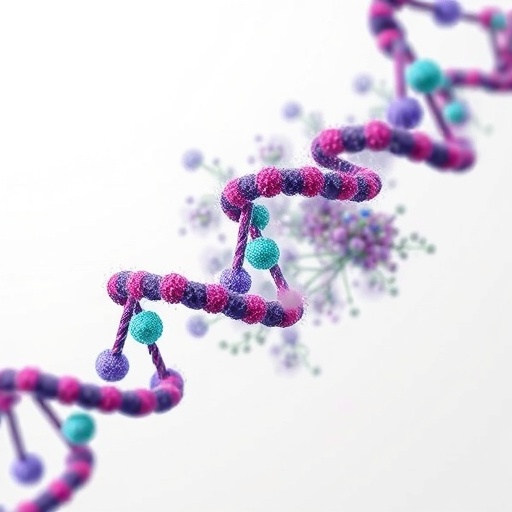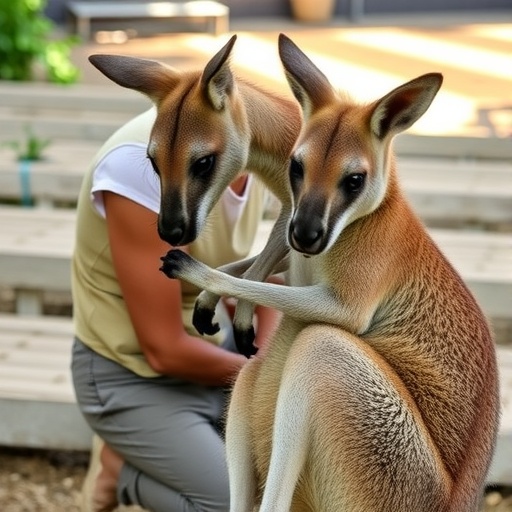In a groundbreaking development that could redefine therapeutic strategies for neurodegenerative disorders, researchers have unveiled an innovative approach utilizing DNA nanoflower Oligo-PROTACs to selectively degrade the Fused in Sarcoma (FUS) protein. This novel technique represents a fusion of molecular biology and nanotechnology, targeting pathological protein accumulations that drive diseases such as amyotrophic lateral sclerosis (ALS) and frontotemporal dementia (FTD). The implications of this work extend beyond conventional therapeutic paradigms, harnessing the precision of engineered biomolecules for unparalleled specificity and efficacy.
Neurodegenerative diseases frequently involve the aberrant accumulation of misfolded or mutated proteins, leading to neuronal dysfunction and cell death. FUS, a DNA/RNA-binding protein implicated in ALS and FTD, has emerged as a key player in the pathogenesis of these disorders. Its pathological aggregates disrupt normal RNA metabolism and cellular homeostasis. Traditional small molecule inhibitors have fallen short due to challenges in selectively targeting such intracellular proteins with minimal off-target effects. Addressing this, the newly designed DNA nanoflower Oligo-PROTAC system introduces a potent platform for targeted protein degradation.
The crux of this technology lies in its two-pronged targeting mechanism. The oligonucleotide segment is tailored to recognize and bind FUS mRNA or its protein product with high specificity, while the PROTAC moiety recruits E3 ubiquitin ligases, marking the bound protein for proteasomal degradation. By conjugating these functionalities onto nanoflowers, the system ensures efficient intracellular delivery, prolonged retention, and amplified degradation signals—all crucial for therapeutic robustness.
Extensive in vitro assays demonstrated that DNA nanoflower Oligo-PROTACs significantly reduce pathological FUS protein levels in neuronal cell lines derived from patient models. These reductions correlated with the restoration of normal cellular functions including RNA processing and stress granule dynamics, which are typically perturbed in FUS-related neurodegeneration. Importantly, cytotoxicity assays confirmed that the nanoflower constructs exhibit minimal adverse effects, underscoring their biocompatibility and therapeutic potential.
Moving beyond cellular systems, the research team employed sophisticated in vivo models mimicking human neurodegenerative disease phenotypes. Systemic administration of the nanoflower Oligo-PROTACs resulted in widespread CNS bioavailability and marked diminution of FUS aggregates within affected brain regions. Behavioral tests in treated animals revealed significant improvements in motor coordination, cognitive performance, and lifespan extension compared to untreated controls. These compelling results highlight the translational prospects of this therapeutic modality.
This technology capitalizes on the inherent programmability of DNA to tailor treatments to individual protein targets by simply redesigning the oligonucleotide sequence. Such modularity paves the way for rapid adaptation against diverse pathological proteins implicated in a spectrum of neurodegenerative and perhaps oncological disorders. Furthermore, the DNA nanoflower platform surmounts key delivery barriers traditionally hampering nucleic acid therapeutics through enhanced cellular uptake and resistance to nucleases.
Beyond its therapeutic implications, the study catalyzes a conceptual shift in drug design—ushering in ‘bionanomachinery’ capable of precise intracellular editing and molecular recycling. This approach aligns with emerging trends in precision medicine that seek to modulate protein homeostasis rather than merely inhibit activity. By exploiting endogenous degradation systems with custom-built nanostructures, these innovations may redefine disease management paradigms.
Nevertheless, challenges remain before clinical translation. The long-term immunogenicity and pharmacokinetics of DNA nanoflowers must be thoroughly characterized. Additionally, scaling efficient and cost-effective manufacturing of complex nanostructures poses a hurdle. The team acknowledges these hurdles and is actively pursuing optimization of delivery vectors and dosing regimens to maximize safety and efficacy in human systems.
Looking forward, the integration of artificial intelligence algorithms to design optimized sequences and scaffold geometries promises to accelerate development cycles. Coupling this with advances in patient-derived organoid models could enable personalized therapeutic screening, heralding a new era of customized molecular degradation therapies. Collaborative efforts bridging nanotechnology, molecular biology, and clinical neuroscience will be critical to realize this vision.
In summary, the introduction of DNA nanoflower Oligo-PROTACs represents an elegant, highly adaptable, and potent strategy for targeted protein degradation, specifically demonstrated in the pathological context of FUS-driven neurodegeneration. By converging the precision of nucleic acid recognition with the catalytic power of the proteasome, this approach offers a beacon of hope for treating devastating diseases currently lacking effective interventions. As research progresses, this platform may spearhead a transformative shift in how intracellular pathogenic proteins are tackled.
The scientific community awaits further preclinical validation and early-phase clinical trials with great anticipation. Should these promising results translate to human patients, DNA nanoflower Oligo-PROTACs could inaugurate a new class of therapeutics that restore cellular balance through precise molecular sculpting. This advancement underscores the profound impact interdisciplinary science can achieve when it marries novel molecular tools with disease-specific targeting.
With ongoing improvements in delivery mechanisms, real-time imaging of nanoflower biodistribution, and integration of biosensing elements, the future holds exciting prospects. The advent of nanoscale devices capable of autonomous disease recognition and elimination may soon transition from conceptual frameworks to tangible clinical realities. This pioneering work not only enriches the toolbox of neurodegenerative disease therapies but sets the stage for combating a wider array of proteinopathies with unparalleled specificity.
Subject of Research: Targeted degradation of FUS protein using DNA nanoflower Oligo-PROTACs for treatment of neurodegenerative diseases.
Article Title: DNA nanoflower Oligo-PROTAC for targeted degradation of FUS to treat neurodegenerative diseases.
Article References:
Ge, R., Chen, M., Wu, S. et al. DNA nanoflower Oligo-PROTAC for targeted degradation of FUS to treat neurodegenerative diseases. Nat Commun 16, 4683 (2025). https://doi.org/10.1038/s41467-025-60039-2
Image Credits: AI Generated
Tags: amyotrophic lateral sclerosis researchDNA nanoflowersfrontotemporal dementia treatmentFUS protein in neurodegenerationmolecular biology innovationsnanotechnology in medicineOligo-PROTAC technologyoligonucleotide-based therapeuticsprotein aggregation disordersselective protein degradation methodstargeted protein degradationtherapeutic strategies for neurodegenerative diseases





